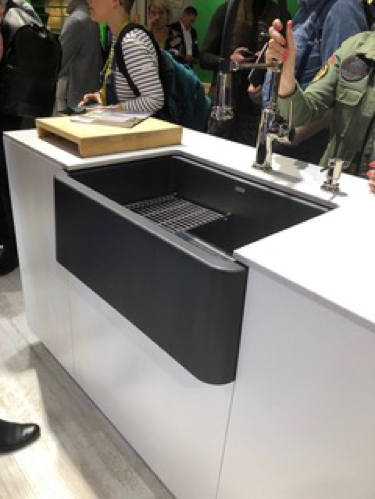Design inspiration in a global setting. By D.J. Carey, editorial director, CTC&G
My quest for what’s new in the world of kitchen designs is ongoing. I have been to KBIS for more years than I care to reveal — and it never gets old. I have been to Milan and recently returned from IMM Cologne/Living Kitchen with NKBA’s Global Connect program. I was excited to see first-hand an entirely new perspective on the kitchen. I am familiar with many German brands that show in New York but was eager to see even more, and some from other countries, too.

I must admit I had some preconceived notions. Yes, I expected clean lines and a sleek silhouette but I often find some designs cold, and not organic. Unlike a few years ago, when it seemed that the American aesthetic was trying to follow the European, this show proved that both markets are evolving at the same time — sometimes with similar ideas, but executed differently. Here are some of my favorite discoveries.
Take, for instance, the farmhouse sink. Many Americans love them (myself included) but I never expected to find them in Germany. In fact, the country look was everywhere you turned in Cologne. Among the many pieces to get the look, I fell in love with the “Faron XL” sink from Blanco. It was both charming and contemporary and would be right at home in my 1860s house in Connecticut.
I was taken with the beautiful “+Venovo” kitchen at Poggenpohl. The designers wanted “to give the room less kitchen but the kitchen more room.” With clean, linear designs, the kitchen unit seems like living-room furniture. This freestanding piece actually incorporates a worktop, oven, refrigerator and sink all in one beautiful unit. And I mean beautiful. As open-concept kitchens evolve, this piece seamlessly works as a kitchen in your living room. Amazing.
Finally, in perhaps the most European aspect of the show, I experienced the exhibition FutureKitchen. In a treatise entitled “Sense & Sensuality,” Alfredo Haberli offers a kitchen for the near future. “The design deals with de-growth both plastically and architecturally,” he says. He created a four-level kitchen: the first with loosely laid bricks, creating noise as you walked on them, meant to slow you down in a sensual way. The second layer is a bright green, intended to separate itself from the rest of the exhibition. The third layer is everyday life with familiar objects that are twisted in a way that confuses the viewer. Finally, an augmented reality app helps you discover newly invented kitchen utensils. It was all meant to be a stimulus, and thanks to its radical abstraction, to encourage reflection. It did all that — and then some — for me.
In fact, the entire visit to Cologne did just that.








